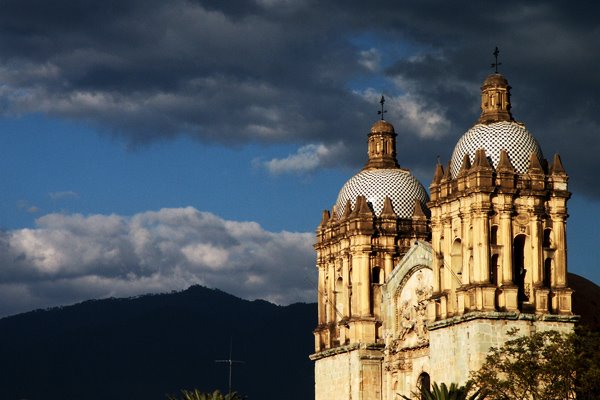Once again, back in Teotitlan del Valle for the danza de la pluma. I am struck by all the different threads and spheres of activity that are a part of the whole. One of the most important aspects is the role of the subalternos or caras negras, who are Jorge Jimenez Mendoza and Pedro Hernandez Lazo for this group of dancers. I managed to catch one of them with a penacho, headdress, which is not his normal head wear.
They have various duties, most importantly to see to the needs of the dancers. One takes care of Monctezuma, Malinche and Doña Marina and the other, the rest of the dancers. That is Monctezuma's penacho. You can tell by the colors and design.
Their duties include tending injuries, providing water, doing repairs and acting as a bridge between audience and the dancers.
They are often very funny as they engage with people. And they can really dance!
More importantly, they represent the two sides of the dialogue, the indigenous and the Spanish and they perform the last dance of the whole performance. It is a little mini battle. Guess who wins?
The here and now... and what and why
Complacency is a trap. At least that’s what I was thinking when I up and left the comfort of a Yankee prep school gig, where I taught music, amongst other things, for 28 years. There was also that life long career as a composer, musician and artist.
First, it was a year in St. Thomas, USVI, working as a reporter and shooting photography and then, a year in San Agustin Etla, Oaxaca, Mexico.
Time passed.
More time passed and a year back in the Athens of America followed by a hasty return to Oaxaca where it is all happening.
A couple of years in San Sebastian Etla and now, just down the road in San Pablo Etla. Life is good.
Click on an image to see it larger.
For additional photography please visit my flickr page.
You can find my music on Jango (World & latin - Worldbeat) and at iTunes and most online stores.
¡Soy consciente de todas las tradiciones del Internet!
If you are coming to Oaxaca, please contact me for tours or advice.
First, it was a year in St. Thomas, USVI, working as a reporter and shooting photography and then, a year in San Agustin Etla, Oaxaca, Mexico.
Time passed.
More time passed and a year back in the Athens of America followed by a hasty return to Oaxaca where it is all happening.
A couple of years in San Sebastian Etla and now, just down the road in San Pablo Etla. Life is good.
Click on an image to see it larger.
For additional photography please visit my flickr page.
You can find my music on Jango (World & latin - Worldbeat) and at iTunes and most online stores.
¡Soy consciente de todas las tradiciones del Internet!
If you are coming to Oaxaca, please contact me for tours or advice.
Santo Domingo

The view from Corazon del Pueblo
The hereafter re me

- Christopher Stowens
- Oaxaca, Oaxaca, Mexico
- Musician, photographer, videographer, reporter, ex-officio teacher, now attempting to be a world traveler





No comments:
Post a Comment